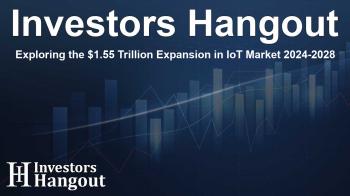Exploring the $1.55 Trillion Expansion in IoT Market 2024-2028

Understanding the Growth of the IoT Market
The Internet of Things (IoT) market is on the brink of a hefty expansion, projected to grow remarkably by USD 1.55 trillion during the forecast period of 2024 to 2028. This growth trajectory, according to recent analysis, is attributed primarily to advancements in IoT platforms and innovations driven by artificial intelligence.
Market Dynamics Shaping the Future of IoT
The driving force of growth in the IoT landscape is heavily influenced by technological advancements that foster the adoption of smart connected devices. Companies are increasingly using IoT solutions to enhance operational efficiency, automate processes, and improve decision-making. This trend is evident across various sectors, including manufacturing, healthcare, logistics, and retail. The incorporation of AI in these sectors serves as a catalyst for change, enhancing capabilities such as data processing and real-time analytics.
Trends in IoT Technology
Several emerging trends are set to transform the IoT market. Generative AI is making waves as a powerful tool for predictive analytics, enhancing machine learning applications and elevating the decision-making processes of companies. Furthermore, blockchain technology is carving a niche in IoT deployment, providing secure data transactions and improving trust among stakeholders.
Wearable Technology and Health Monitoring
One appealing segment of the IoT market is the rising demand for wearable technology. Devices aimed at monitoring health and environmental conditions are gaining traction. Smart wearables not only aid individuals in keeping track of health metrics but also provide invaluable data for healthcare professionals to remotely monitor their patients. This intersection of technology and healthcare is a vital evolution in delivering personalized care.
Challenges Facing the IoT Market
Despite the positive growth outlook, several challenges could impede the market’s expansion. For instance, a significant barrier lies in the lack of awareness and understanding of efficient management of IoT initiatives. Companies face hurdles related to investment returns, as realizing the full potential of IoT solutions necessitates a commitment to employee training and education around these technologies.
Addressing Workforce Challenges in IoT
As the IoT ecosystem expands, the need for skilled workers becomes increasingly critical. Many organizations struggle to find personnel adequately trained in IoT platforms. To surmount these challenges, businesses must invest in workforce development initiatives that equip employees with necessary skills and knowledge to leverage IoT technologies effectively.
The Path Forward for IoT
The adoption of advanced networking technologies, such as 5G and NB-IoT, is essential for the ongoing success of IoT applications. These technologies provide the backbone for enhanced connectivity and data processing capabilities required for smart city initiatives and consumer-driven innovations. The increasing integration of IoT into various operational frameworks underscores the trend toward digital transformation across industries.
The Role of Cloud and Connectivity
Cloud services play a fundamental role in the IoT ecosystem, enabling businesses to manage and analyze vast amounts of data generated from connected devices. This shift enables decision-makers to harness actionable insights, optimizing processes and improving service delivery. Coupled with data privacy concerns, businesses must create robust strategies for data security and compliance.
Conclusion: Anticipating Changes in the IoT Market
In conclusion, the IoT market presents an exciting frontier ripe with opportunities for innovation and growth. As we can expect a considerable uptick in revenue, businesses must proactively adapt to changes in technology and consumer behavior to remain competitive in this dynamic landscape. Developing strategic approaches to tackle existing challenges while harnessing emerging technologies will be key in shaping the future of the IoT market.
Frequently Asked Questions
What is the expected growth of the IoT market by 2028?
The IoT market is anticipated to grow by USD 1.55 trillion from 2024 to 2028.
What technologies are driving growth in IoT?
Technologies like Generative AI, blockchain, and advanced networking infrastructures such as 5G are driving growth in the IoT sector.
What are the main challenges facing the IoT market?
Challenges include a lack of awareness of efficient management practices and the need for skilled workforce in IoT technologies.
How does wearable technology fit into IoT developments?
Wearable technology is becoming increasingly popular for personal and remote health monitoring, representing an essential facet of IoT advancements.
Why is cloud adoption significant for IoT?
Cloud adoption is crucial as it facilitates the management and analysis of large amounts of data from connected devices, driving effective business insights.
About Investors Hangout
Investors Hangout is a leading online stock forum for financial discussion and learning, offering a wide range of free tools and resources. It draws in traders of all levels, who exchange market knowledge, investigate trading tactics, and keep an eye on industry developments in real time. Featuring financial articles, stock message boards, quotes, charts, company profiles, and live news updates. Through cooperative learning and a wealth of informational resources, it helps users from novices creating their first portfolios to experts honing their techniques. Join Investors Hangout today: https://investorshangout.com/
Disclaimer: The content of this article is solely for general informational purposes only; it does not represent legal, financial, or investment advice. Investors Hangout does not offer financial advice; the author is not a licensed financial advisor. Consult a qualified advisor before making any financial or investment decisions based on this article. The author's interpretation of publicly available data shapes the opinions presented here; as a result, they should not be taken as advice to purchase, sell, or hold any securities mentioned or any other investments. The author does not guarantee the accuracy, completeness, or timeliness of any material, providing it "as is." Information and market conditions may change; past performance is not indicative of future outcomes. If any of the material offered here is inaccurate, please contact us for corrections.
